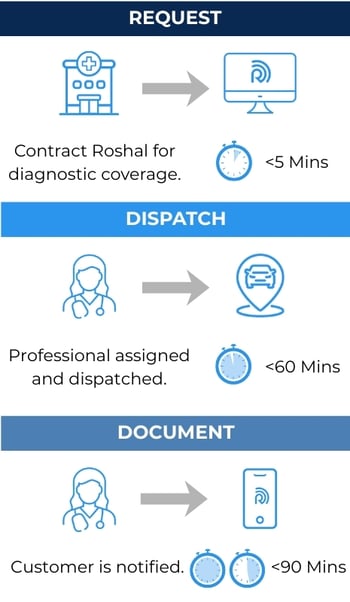Healthcare Professionals On-Site in 60 Minutes
The only technology platform delivering certified
healthcare professionals on-demand, nationwide










Trusted by leading health systems nationwide






OUR SERVICES
On-demand, tech-enabled clinical diagnostics and staffing. Anywhere, in under 60 minutes.
Nationwide coverage across imaging, cardio/neuro diagnostics, allied therapies, reads, and clinical-trial
support; powered by SmartMatch, verified in real time, EHR-integrated, and backed by SLA-level speed.

On-Demand Diagnostics
Use our technology to request single studies as needed, scale up or down instantly.

Scheduled Shift Coverage
Skilled professionals—on-demand for full shifts, when and where you need them.

Clinics On-Demand
Fully managed end-to-end solution. People, equipment, logistics, and diagnostics all seamlessly coordinated.
Minutes, not months.
Rapid, compliant coverage.
Submit your request, and our dispatch engine instantly matches credentialed professionals by role and region. We deploy on-site or remote with full compliance, seamless EHR integration, and end-to-end tracking.


OUR CUSTOMERS
Trusted by leading health
systems nationwide.


“Roshal Health has been so helpful to our Emergency Room ultrasound needs. The team has been wonderful to work with. The collaboration is great. The techs do a good job. When I have unexpected staffing challenges, all I have to do is ask for help, and more times than not, Roshal Techs are able to cover.”

Dana Shearer
HCA
OUR MODALITIES
Delivered by licensed and certified
healthcare professionals.

Ultrasound & Echocardiogram

X-ray & CT Scan

EKG

Maternal & Fetal Medicine

Mammography

Nuclear Medicine

MRI

Vitals, Bloodwork, & Labs

Pulmonary Function Test

OT, PT, & Speech Therapy
Request single studies as needed or scale up or down instantly.
OUR CLINICAL SETTINGS
From ED chaos to clinic calm.
Wherever care happens, we move fast.
A single, scalable clinical-deployment platform for health systems, free-standing
EDs, physician groups, ambulatory clinics, VA/DoD, tribal and rural facilities, and
research networks.

Emergency (ED)
Radiology
Neurology
Oncology
Pediatrics
ICU/Critical Care
Cardiology
OB/GYN
Rehabilitation
Orthopedics
Surgical Services
Urgent Care
Outpatient Imaging
Freestanding ED
Ambulatory Surgery
Outpatient PT
Primary Care

Specialty Clinics
Outpatient Rehab
CONTACT
Get in touch now
Need on-site staff or looking for flexible work? Complete our form and we'll be in touch.
49+
States across the nation
20+
Years of industry experience
49+
States across the nation
20+
Years of industry experience
